- Cedar top
- Depth at lower bout: 4 3/16 inches
- Width of neck at nut: 2 inches
- Body length: 19 3/4
-
Out of stock
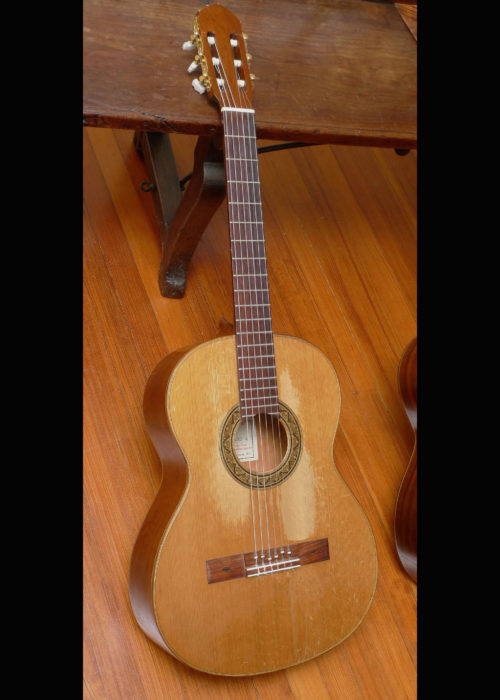
-
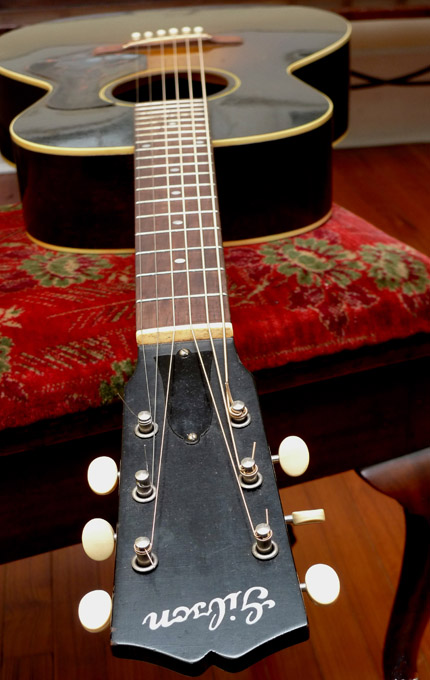 Crack-free, and 100% original, down to the bridge pins, and the original Geib case. Just getting a neck set to make it play perfectly.
Crack-free, and 100% original, down to the bridge pins, and the original Geib case. Just getting a neck set to make it play perfectly. -
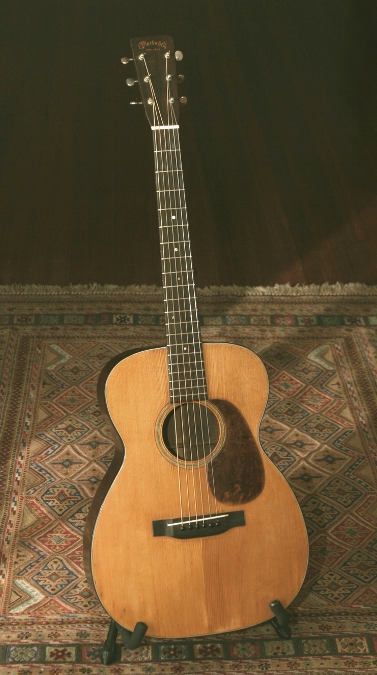 Probably the best year ever for 14-fret 00-18s. In the Golden Age of 14-fret Martins from the early 30's until the late 30's, only in 1936 did Martin use Brazilian rosewood (as opposed to ebony) for the fretboard and bridges of 18's, so its tone is considered by many to be the best in the 14 fret, 1-3/4 inch nut era. The guitar is crack-free on the top and back. Just one repaired crack on the treble side.The repair is well done and almost impossible to see from the outside (older repair has muslin cloth on inside-luthiers agree that these older cloth patches inside a vintage Martin should be left in place). Original tuners. Original bridge plate. Original nut. Replaced T-frets by us. Replacement bridge-very dark Brazilian rosewood bridge made to original specs in our shop, and ivory saddle. The neck has that wonderful mid-thirties slightly fatter profile. Neck set by us. And the tone is the best example of a Golden Era 00-18 you'll find anywhere. Light overspray (no refinishing) on back and sides (not top, neck or head).
Probably the best year ever for 14-fret 00-18s. In the Golden Age of 14-fret Martins from the early 30's until the late 30's, only in 1936 did Martin use Brazilian rosewood (as opposed to ebony) for the fretboard and bridges of 18's, so its tone is considered by many to be the best in the 14 fret, 1-3/4 inch nut era. The guitar is crack-free on the top and back. Just one repaired crack on the treble side.The repair is well done and almost impossible to see from the outside (older repair has muslin cloth on inside-luthiers agree that these older cloth patches inside a vintage Martin should be left in place). Original tuners. Original bridge plate. Original nut. Replaced T-frets by us. Replacement bridge-very dark Brazilian rosewood bridge made to original specs in our shop, and ivory saddle. The neck has that wonderful mid-thirties slightly fatter profile. Neck set by us. And the tone is the best example of a Golden Era 00-18 you'll find anywhere. Light overspray (no refinishing) on back and sides (not top, neck or head). -
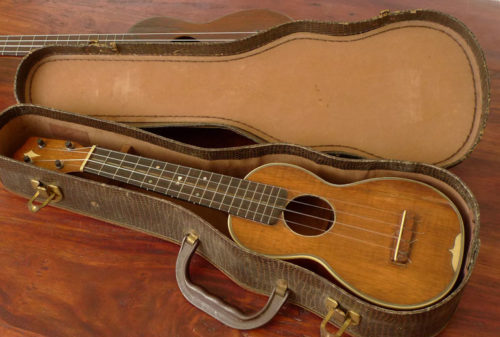 One of the first Martin 3K Ukeleles ever made. This is possibly a prototype, one of the first, all hand-made Martin 3K Ukeleles, made probably before the official introduction of the model by Martin in 1919-1920. It has many signs that it was the one of the first ones:
One of the first Martin 3K Ukeleles ever made. This is possibly a prototype, one of the first, all hand-made Martin 3K Ukeleles, made probably before the official introduction of the model by Martin in 1919-1920. It has many signs that it was the one of the first ones:- Ebony fretboard is hand-cut
- Fretboard inlays are hand-cut
- There is an "A" on the back of headstock... could be a marking by the Martin craftsmen in-house to indicate a prototype.
- Several cracks on back (repaired)
- Two cracks on top (repaired)
- There is one missing brace, a back brace, inside. Since ukeleles are so small, that brace has no real structural importance, so we decided not to replace it
- The sound hole was at some point enlarged slightly, either at the factory, or later. Probably later– so we’ll call it the Tony Rice model… this modification does add loudness
- The finish is all original.
- Original striped nut
- 3 lines inlaid down center of fingerboard.
- 7 ply side binding
- Celluloid ornament on top, behind bridge (known as the "parend").
- Small pearl paired-diamond inlays at fret 5, 7, 9– hand-cut. With the “bowtie” at the 7th fret
- Kite-shaped celluloid ornament on front of headstock
- Original friction pegs
- Ebony fretboard
- C.F. Martin & Co. stamp on back of headstock.
-
 A chance to own a great sounding, great playing Brazilian Rosewood D-28, at a fraction of the cost of an all-original example. This D-28 has had some work, and a few issues, but it’s all repaired and ready to play. And the tone is incredible– tone you won’t find in any other mid-50’s D-28. This guitar, has just been gone over head to end pin, repaired, restored, and set up, by two of the top luthiers/repairmen in Texas, and it’s good to go for decades. The bridge is perfect. Saddle is perfect height. Action is great– low but no buzzing. It won’t need a thing. Ready to play. The tone: the scalloped braces add roundness and clarity to the basses (A and D string in particular) and a bit more “ring” to the trebles. Don’t try this at home– a scalloped braced mid 50’s D-28, but the result, set up by two of this country’s top luthiers, is a great sounding brazilian Martin dread, whose tone you won’t find in any Martin north of 1944– certainly not at this price. Here’s the report:
A chance to own a great sounding, great playing Brazilian Rosewood D-28, at a fraction of the cost of an all-original example. This D-28 has had some work, and a few issues, but it’s all repaired and ready to play. And the tone is incredible– tone you won’t find in any other mid-50’s D-28. This guitar, has just been gone over head to end pin, repaired, restored, and set up, by two of the top luthiers/repairmen in Texas, and it’s good to go for decades. The bridge is perfect. Saddle is perfect height. Action is great– low but no buzzing. It won’t need a thing. Ready to play. The tone: the scalloped braces add roundness and clarity to the basses (A and D string in particular) and a bit more “ring” to the trebles. Don’t try this at home– a scalloped braced mid 50’s D-28, but the result, set up by two of this country’s top luthiers, is a great sounding brazilian Martin dread, whose tone you won’t find in any Martin north of 1944– certainly not at this price. Here’s the report:- sometime decades ago, the top braces were scalloped
- probably as a result of a minor impact at the end pin (guitar dropped), there were cracks in the sides, and a slight crack to the neck block. So a previous luthier, long before we acquired the guitar, put in 4 small wood dowels, through the sides–near the heel, into the block (see photos). All is stable. Not the prettiest solution, but it works well.
- Small crack in heel, repaired and stable
- Original finish, on Sitka Spruce top; Oversprayed back, sides, and neck (but back of neck finish has worn, giving a natural, comfortable feel)
- A bit of damage to one corner of the headstock. But there are no cracks in headstock.
- Pickup jack installed years ago at end pin; no pickup inside; Also, an old pickup jack on bass side of guitar, filled.
- Some pickwear loss, bottom edge of soundhole
- Top of guitar has no serious cracks. No "B string" pickguard crack. Tiny crack along the treble edge of the pick guard. A couple more finish type of cracks that do not go through the wood to inside.
- Several side cracks, all addressed.
- Back of guitar has no cracks through the wood. A couple of finish cracks.
- neck set, by John Allison
- Refret, by John Allison
- New, 100% period correct, ebony bridge, made and installed by John Allison. Bridge is made to the exact specs, footprint, etc, of an original 1956 Martin bridge. A small area of finish around an older oversized bridge was addressed by John (you can see this in the photos).
- New, period correct Maple bridge plate, installed by Tony Nobles
- Old pickup jack on bass side of guitar, filled by Tony Nobles.
- The wonderful, original gold-plated Kluson waffle-back tuners, are original, and work perfectly.
- Original pickguard
- Original Martin logo on headstock
-
 Another Gibson L-00, with great tone and volume, and all original finish. The top and sides are completely crack-free, and there are several small dryness cracks on the back. The bridge is original, and has never been off the guitar. We just set the neck, and installed a new bone saddle. The bridge plate is original and in perfect condition. Original firestripe pickguard. Original nut. Original frets.
Another Gibson L-00, with great tone and volume, and all original finish. The top and sides are completely crack-free, and there are several small dryness cracks on the back. The bridge is original, and has never been off the guitar. We just set the neck, and installed a new bone saddle. The bridge plate is original and in perfect condition. Original firestripe pickguard. Original nut. Original frets. -
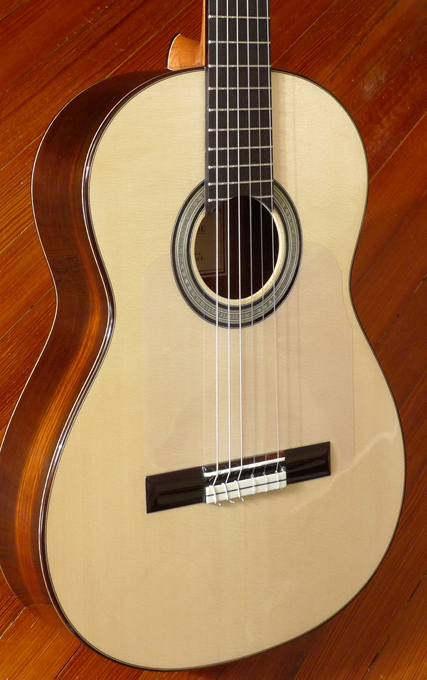 This new, custom made Lester Devoe Flamenco Negra is amasterpiece, from one of the world’s top luthiers. Lester Devoe needs nointroduction to the world’s great Flamenco players. The late, legendary Sabicasplayed a Devoe– and converted some of the great Flamenco players in Spain tothe fold. Paco De Lucia, and Vicente Amigo, among others, play Devoe Flamencoguitars. Paco De Lucia began playing a Devoe Negra guitar years ago– and thereare many Paco De Lucia recordings and feature films where Paco plays a DevoeFlamenco guitar.) This is the second custom guitar, that Lester has made for uswith select, old growth, quartersawn AAAAA Brazilian rosewood. Signed by LesterDevoe, 2012 (March).
This new, custom made Lester Devoe Flamenco Negra is amasterpiece, from one of the world’s top luthiers. Lester Devoe needs nointroduction to the world’s great Flamenco players. The late, legendary Sabicasplayed a Devoe– and converted some of the great Flamenco players in Spain tothe fold. Paco De Lucia, and Vicente Amigo, among others, play Devoe Flamencoguitars. Paco De Lucia began playing a Devoe Negra guitar years ago– and thereare many Paco De Lucia recordings and feature films where Paco plays a DevoeFlamenco guitar.) This is the second custom guitar, that Lester has made for uswith select, old growth, quartersawn AAAAA Brazilian rosewood. Signed by LesterDevoe, 2012 (March).- 650mm scale length
- Nut: 52mm
- Neck width at nut: 52mm
- 80 year old Brazilian Rosewood (pre-CITES) back and sides (Quartersawn).
- European spruce top
- Cedar neck
- Brazilian Rosewood headstock overlay, and bridge
- Brazilian Rosewood body binding, top and back
- Ebony fingerboard
- Sloane tuners
- Nitrocellulose lacquer finish
-
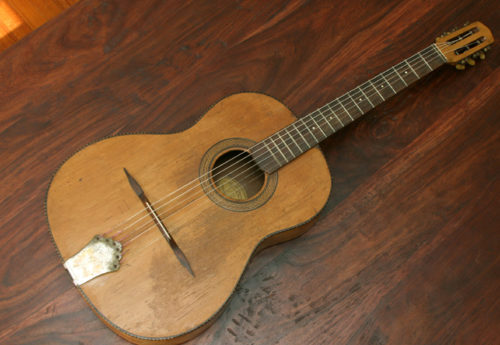 When Martin entered into its “Golden Age” for the flat top guitar, the jazz guitar was evolving on a parallel and equally important track. And in Europe, especially France, they had their own ideas about guitar making, and produced some brilliant guitars in this era–including of course the wonderful Selmer gypsy jazz guitar. The brothers Gerome were among the best luthiers in Mirecourt, France, a city famous in Europe for producing the finest gypsy and jazz guitars, in the 20s, 30s, and 40s. This all original, gypsy style guitar has maple back and sides, to give that high, twangy tone, just what you want in a django-style guitar. This one has loud piercing trebles–the treble strings are louder and more piercing than any guitar of any kind I have ever heard. Only maple produces that loud sharp treble. The volume of this instrument is striking, and there is almost a “reverb”, resonant quality to the tone. Solid spruce top. Black & white checkerboard marquetry binding on top, and rosette. It has a very thick rosewood fingerboard (over 4/10 inches/10.5mm thick!) Maple neck. Nut just shy of 1 7/8 inch. Wonderful bakelite buttons on the tuners. And it would not be a genuine gypsy jazz classic, if it did not have the hallmarks of this style: the original “floating bridge”–not an “adjustable brigde” for height, but a floating rosewood bridge that is not glued to the top, but held on by string tension (the “wings” of the bridge are glued to the top in this configuration). (You can of course change the intonation with this set-up.) The other feature that is a must, is the “zero fret”, i.e. there is a fret (the “zero” fret) right in front of the nut. 14-5/8 inch wide at lower bout. All original finish. A couple of small cracks on top. Top center seam repair. Original T-frets show wear, but still work fine. No buzzing. Action is good. Takes loop-end strings (available from many sources–Savarez Argentine strings are great on this instrument).
When Martin entered into its “Golden Age” for the flat top guitar, the jazz guitar was evolving on a parallel and equally important track. And in Europe, especially France, they had their own ideas about guitar making, and produced some brilliant guitars in this era–including of course the wonderful Selmer gypsy jazz guitar. The brothers Gerome were among the best luthiers in Mirecourt, France, a city famous in Europe for producing the finest gypsy and jazz guitars, in the 20s, 30s, and 40s. This all original, gypsy style guitar has maple back and sides, to give that high, twangy tone, just what you want in a django-style guitar. This one has loud piercing trebles–the treble strings are louder and more piercing than any guitar of any kind I have ever heard. Only maple produces that loud sharp treble. The volume of this instrument is striking, and there is almost a “reverb”, resonant quality to the tone. Solid spruce top. Black & white checkerboard marquetry binding on top, and rosette. It has a very thick rosewood fingerboard (over 4/10 inches/10.5mm thick!) Maple neck. Nut just shy of 1 7/8 inch. Wonderful bakelite buttons on the tuners. And it would not be a genuine gypsy jazz classic, if it did not have the hallmarks of this style: the original “floating bridge”–not an “adjustable brigde” for height, but a floating rosewood bridge that is not glued to the top, but held on by string tension (the “wings” of the bridge are glued to the top in this configuration). (You can of course change the intonation with this set-up.) The other feature that is a must, is the “zero fret”, i.e. there is a fret (the “zero” fret) right in front of the nut. 14-5/8 inch wide at lower bout. All original finish. A couple of small cracks on top. Top center seam repair. Original T-frets show wear, but still work fine. No buzzing. Action is good. Takes loop-end strings (available from many sources–Savarez Argentine strings are great on this instrument). -
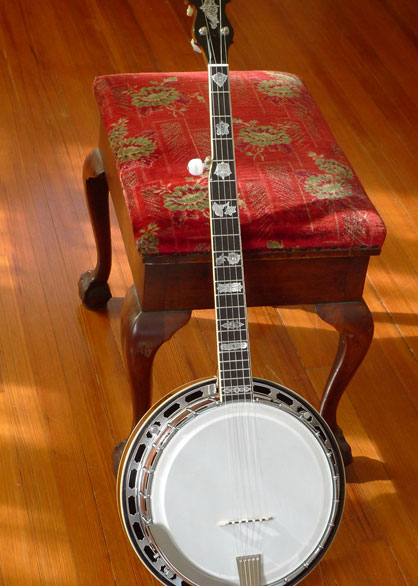 Late 1970s, but in almost unplayed condition. Bluegrass banjo players seek out these 70’s Whyte Eagles, known for their tone and craftsmanship. It was a pretty short window of only about five years, when these banjos were made with this kind of craftsmanship. They blow away most any banjo made and marketed (from any country) in the 60s, 70s and 80s– and they show no logos on headstock– just beautiful mother of pearl. It’s the No. 4310 “Whyte Eagle”. Based on late 1920’s Vega Griffin (Tubaphone #9) style inlays, with engraved, carved heel. Sunburst finish maple banjo, Gibson-style 2 piece flange, full height 20 hole archtop tone ring, dual coordinator rods, flamed maple resonator, maple neck, chrome finish. Neck is butterfly with ebony strip on back of neck, down the center. Just set up, with new tailpiece, and new head, by Dave Trexle and ready to play: loud, clear, and bright. With original hard shell case.
Late 1970s, but in almost unplayed condition. Bluegrass banjo players seek out these 70’s Whyte Eagles, known for their tone and craftsmanship. It was a pretty short window of only about five years, when these banjos were made with this kind of craftsmanship. They blow away most any banjo made and marketed (from any country) in the 60s, 70s and 80s– and they show no logos on headstock– just beautiful mother of pearl. It’s the No. 4310 “Whyte Eagle”. Based on late 1920’s Vega Griffin (Tubaphone #9) style inlays, with engraved, carved heel. Sunburst finish maple banjo, Gibson-style 2 piece flange, full height 20 hole archtop tone ring, dual coordinator rods, flamed maple resonator, maple neck, chrome finish. Neck is butterfly with ebony strip on back of neck, down the center. Just set up, with new tailpiece, and new head, by Dave Trexle and ready to play: loud, clear, and bright. With original hard shell case. -
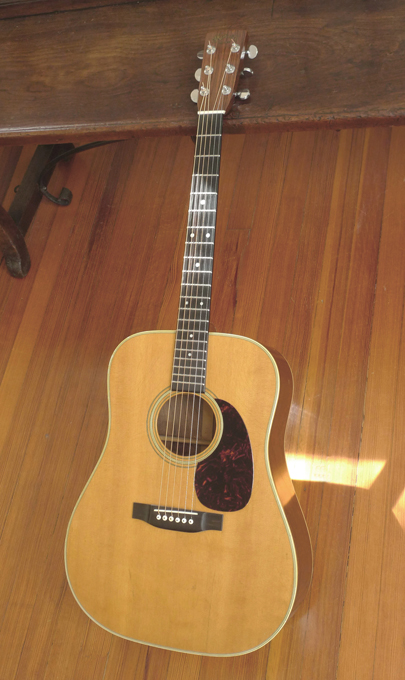 Very Nice Brazilian Rosewood D-28 dreadnaught.
Very Nice Brazilian Rosewood D-28 dreadnaught.- All original finish, bridge, bridge plate, tuners
- Newer saddle and nut, just installed to give perfect action, tone
- Original Tortoise pickguard
- Original small maple bridge plate, great condition
- Typical small “pickguard crack” as almost vintage Martins with pickguards have. It was professionally closed/glued years ago, stable and no longer an issue. There is a 4 2/3 inch finish crack, with 2 inches or so of that just barely visible from inside– located from edge of lower bout up, about 3 inches to the treble side of the center seam… professionally closed/glued years ago, stable and not an issue now
- Brazilian Rosewood back and sides: crack-free
- 100% original finish, everywhere. No overspray or finish alterations of any kind. Minor dings and some minor pickwear around the soundhole.
- Has never had a strap lug attached to the wood of the heel itself. There is a strap lug attached to the ivoroid heel cap.
- Original frets are in great condition… just a bit of wear, on frets 1-3/B string only
- Action is great– low and fast and loud, and neck angle is fine. Plenty of saddle left.
- Typical crazing of finish on top and back as seen on almost all mid-60s Martins (finish is all original, everywhere)
-
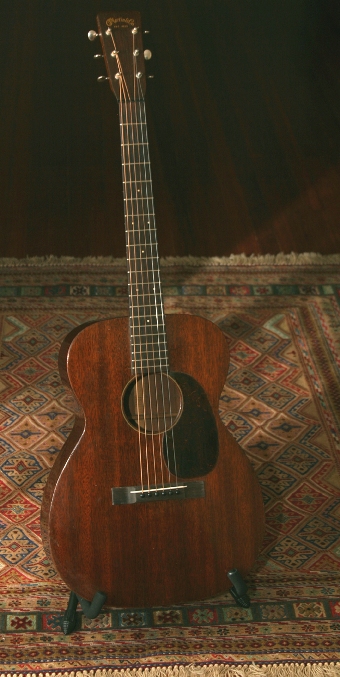 This model is something of a sleeper on the Golden Era Martin guitar market, because there are just not that many pre-1939 00-17s available. There are quite a few war-time and post-war 00-17s, but a 00-17 with full pre-war specs, forward shifted X-bracing, and 1 3/4 inch nut, is hard to come by–and they have all the great qualities of 00-sized Golden Era Martins that cost twice or three times the price on the vintage market–for now, as these great pre-war 00-17s will catch up quickly. The tone and volume of this 00-17 is astounding: full, amazingly bright, and with impressive volume. 1-3/4 inch nut width. Crack-free except for a well-repaired crack on bass side, about 2 inches long, that's difficult to see even up close. No cracks at all on top, or back. All original finish. Original bridge plate. This model has of course a mahogany top as well as mahogany back and sides. And with that dark look and original gloss finish that really sets this Golden Age Martin apart in its own class. Neck has the typically slightly beefier profile that's the hallmark of the best 30's 14-fret Martins. Neck was set by us. Replaced, period-correct Brazilian rosewood bridge. Original ebony nut. All new T-frets installed by us. Original tuners.
This model is something of a sleeper on the Golden Era Martin guitar market, because there are just not that many pre-1939 00-17s available. There are quite a few war-time and post-war 00-17s, but a 00-17 with full pre-war specs, forward shifted X-bracing, and 1 3/4 inch nut, is hard to come by–and they have all the great qualities of 00-sized Golden Era Martins that cost twice or three times the price on the vintage market–for now, as these great pre-war 00-17s will catch up quickly. The tone and volume of this 00-17 is astounding: full, amazingly bright, and with impressive volume. 1-3/4 inch nut width. Crack-free except for a well-repaired crack on bass side, about 2 inches long, that's difficult to see even up close. No cracks at all on top, or back. All original finish. Original bridge plate. This model has of course a mahogany top as well as mahogany back and sides. And with that dark look and original gloss finish that really sets this Golden Age Martin apart in its own class. Neck has the typically slightly beefier profile that's the hallmark of the best 30's 14-fret Martins. Neck was set by us. Replaced, period-correct Brazilian rosewood bridge. Original ebony nut. All new T-frets installed by us. Original tuners. -
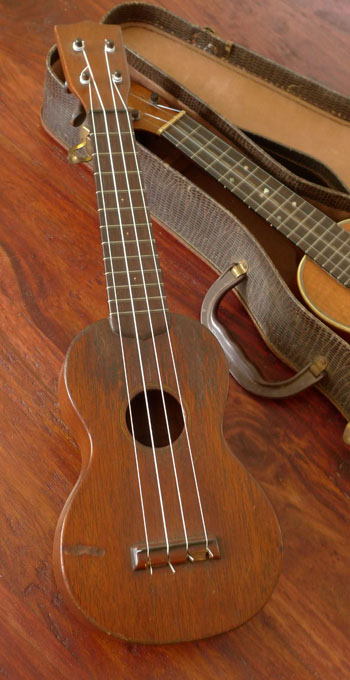 A pre-decal Uke from Martin. Style 0, with no body binding. Well worn, but 100% crack free.
A pre-decal Uke from Martin. Style 0, with no body binding. Well worn, but 100% crack free.